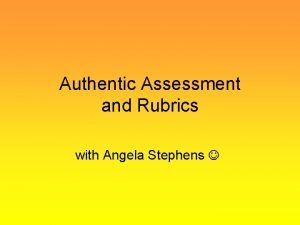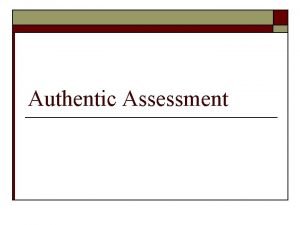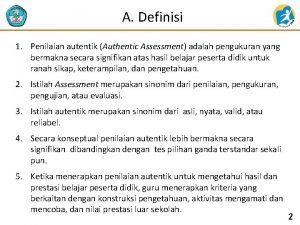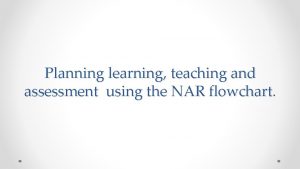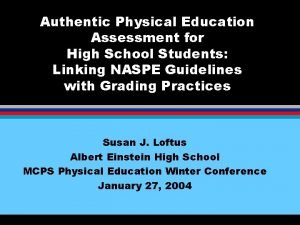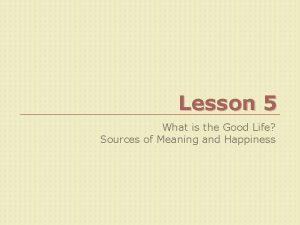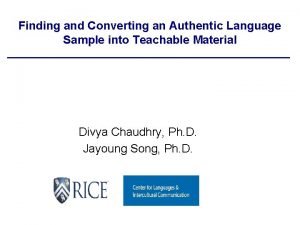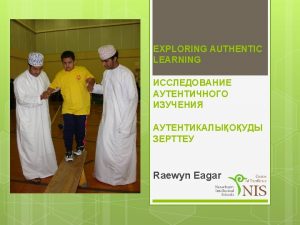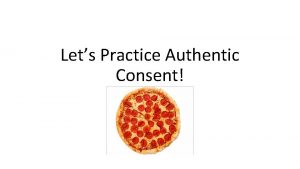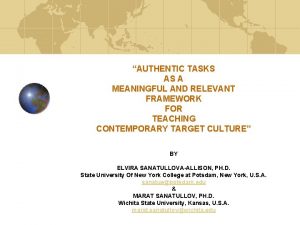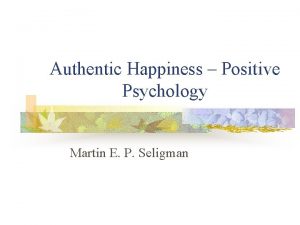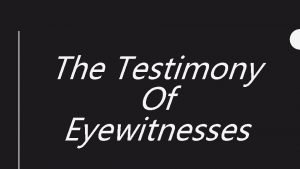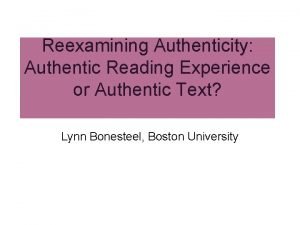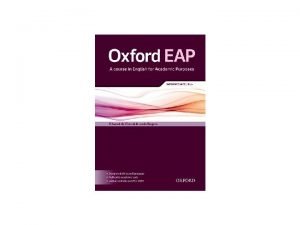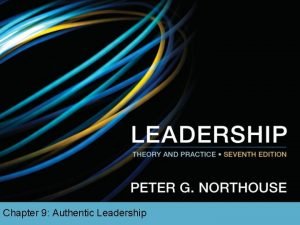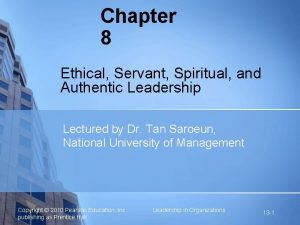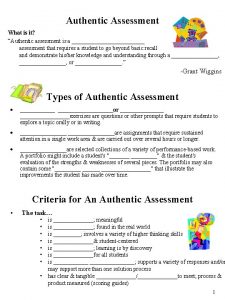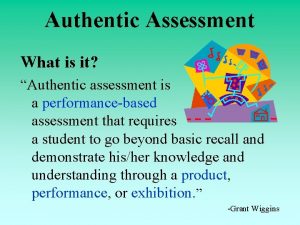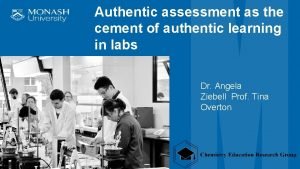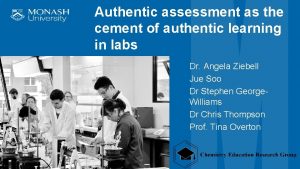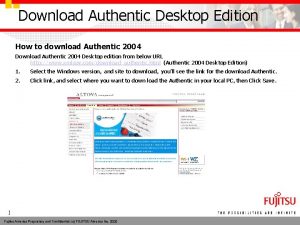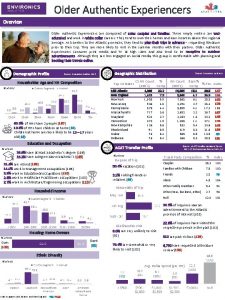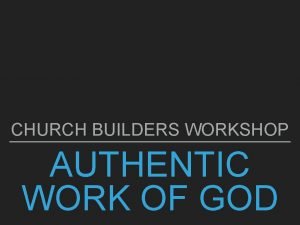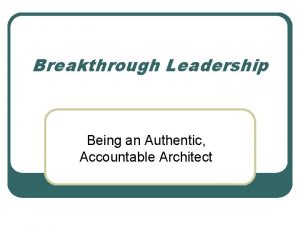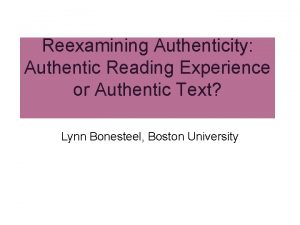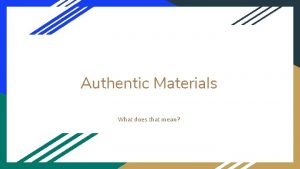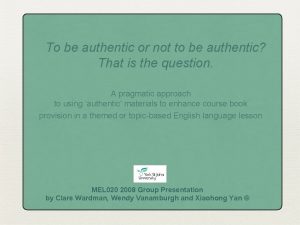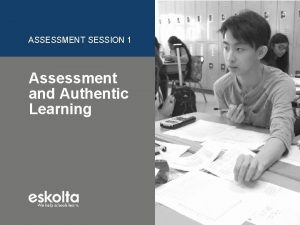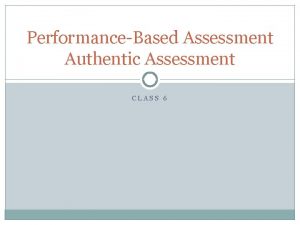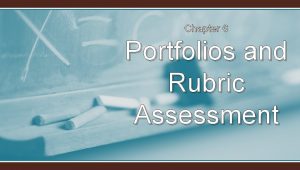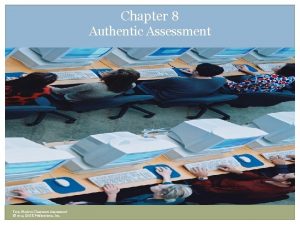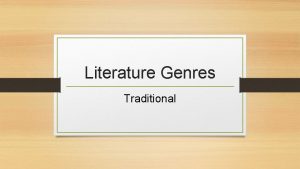Traditional Vs Authentic Assessment Traditional Assessment Definition Traditional






















- Slides: 22

Traditional Vs. Authentic Assessment

Traditional Assessment Definition: Traditional assessment are the conventional methods of testing such as: quiz. exam. paper. Standardized tests. most state achievement test. high school graduation examination.

Authentic Assessment Definition: An assessment that is performanceoriented, the thinking goes, with the assessment that aims to measure not only the correctness of the response, but also the thought process involved in arriving at the response, and that encourage students to reflect their own learning in both depth and breadth, the belief is that instruction will be pushed into a more thoughtful, more reflexive, richer mode as well.

Alternative Names for Authentic Assessment Performance Assessment Alternative Assessment Direct Assessment

Other Definitions: Performance assessments call upon the examinee to demonstrate specific skills and competencies, that is, to apply the skills and knowledge they have mastered. Richard J. Stiggins

Other Definitions: A form of assessment in which students are asked to perform real-world tasks that demonstrate meaningful application of essential knowledge and skills Jon Mueller

Traditional Assessment vs. Authentic Assessment: Traditional Assessment (TA) Multiple choice Gap fill True-false Matching

Traditional Assessment vs. Authentic Assessment: Authentic Assessment (AA) Inventories Peer rating / Self rating Journals Portfolios Discussions Interviews

Traditional Assessment vs. Authentic Assessment: Traditional (TA) • To develop productive citizens • Must possess a body of knowledge and skills • Schools must teach this body of knowledge and skills • Test the students if they acquired the knowledge and skills Authentic (AA) • To develop productive citizens • Must be capable of performing real tasks • Schools must help students become proficient at performing tasks • Have the students perform meaningful tasks

Traditional Assessment vs. Authentic Assessment: Traditional (TA) • The curriculum drives assessment. • 1. body of knowledge is determined first • 2. design the curriculum • 3. assess to determine if acquisition of the curriculum occurred. Authentic (AA) • Assessment drives the curriculum. • 1. tasks are determined first • 2. students perform to demonstrate their mastery • 3. design the curriculum

Traditional Assessment vs. Authentic Assessment: Traditional (TA) Authentic (AA) • Selecting a response • Contrived • Recall / Recognition • Teacher-structured • Indirect evidence • Performing a task • Real-life • Construction / Application • Student-structured • Direct evidence

How to Create Authentic Assessments Step 1: Identify the standards Step 2: Select an authentic task Step 3: Identify the criteria for the task Step 4: Create the rubric

STEP 1: Identify the Standards, like goals, are statements of what students should know and be able to do. However, standards are typically more narrow in scope and more amenable to assessment than goals. “Students will be able to add two-digit numbers correctly. ”

STEP 2: Select an Authentic Task Find a way students can demonstrate that they are fully capable of meeting the standard. The language of a well-written standard can spell out what a task should ask students to do to demonstrate their mastery of it.

STEP 3: Identify the Criteria for the Task Ask "What does good performance on this task look like? " or "How will I know they have done a good job on this task? " • Criteria: Indicators of good performance on a task

STEP 3: Identify the Criteria for the Task Characteristics of a Good Criterion clearly stated brief observable statement of behavior written in a language students understand

STEP 3: Identify the Criteria for the Task Standard The student will be able to divide two-digit numbers correctly. Task Calculate the given math problems without using the calculator and answer it in the board. Explain their answers. Criteria The proper use of the step-by-step process in solving the problem. Correctness of the final answer. The way they explain and deliver the reason of how they arrive with the final answer.

STEP 4: Create the Rubric Once you have identified the criteria you want to look for as indicators of good performance, you next decide whether to consider the criteria analytically or holistically.

Holistic Rubric (Accent) Score Level Criteria 4 The student’s accent has no trace of first language influence. Accent is fairly Standard American. 3 The student’s accent is very understandable by a native American although some intonation can be inconsistent and can be traced back to L 1 intonation. 2 The student’s accent is evidently very much affected by L 1 intonation. However, it is fairly understandable. 1 The student’s accent is very much affected by L 1 intonation and it is difficult to understand.

Analytic Rubric (Composition Writing) Criteria Wt 4 3 2 1 x 2 Information in logical, interesting sequence which reader can follow. Student presents information in logical sequence which reader can follow. Reader has difficulty following work because student jumps around. Sequence of information is difficult to follow. Content x 2 Student demonstrates full knowledge (more than required). Student is at ease with content, but fails to elaborate. Student is uncomfortable with content and is able to demonstrate basic concepts. Student does not have grasp of information; student cannot answer questions about subject. Vocabulary x 1 Few errors; precise and appropriate Fairly broad vocabulary; some errors Adequate but repetitive ; invented words Words don’t fit the context; hard to understand Neatness x 1 Work is neatly done. Work has one or two areas that are sloppy. Work has three or four areas that are sloppy. Work is Illegible. Organization

Experts Say… “For many students, assessment is not an educational experience in itself, but a process of ‘guessing what the teacher wants. ’” Ø(Mc. Laughlin & Simpson, 2004)

Bibliography: • http: //www. slideshare. net/xanderjoy/authe ntic-assessment-2104700 • http: //www. sedl. org/loteced/comparing_as sessment. html
 Rubric for authentic assessment
Rubric for authentic assessment Authentic tasks meaning
Authentic tasks meaning Authentic assessment adalah
Authentic assessment adalah Authentic assessment
Authentic assessment Authentic assessment
Authentic assessment Authentic assessment
Authentic assessment Authentic assessment in physical education
Authentic assessment in physical education Leadership authentic
Leadership authentic A meaningful authentic good life is based on
A meaningful authentic good life is based on Authentic language examples
Authentic language examples Authentic learning
Authentic learning Authentic consent
Authentic consent Authentic dialogue philosophy ppt
Authentic dialogue philosophy ppt Authentic task
Authentic task Www.authentichappiness.org
Www.authentichappiness.org Josephine bracken
Josephine bracken Authentic text
Authentic text Oxford eap a course in english for academic purposes
Oxford eap a course in english for academic purposes Authentic leadership focuses on
Authentic leadership focuses on Ethical servant spiritual and authentic leadership
Ethical servant spiritual and authentic leadership Authentic relationship with god
Authentic relationship with god Authentic project proposal
Authentic project proposal Authentic leadership theory and practice
Authentic leadership theory and practice
